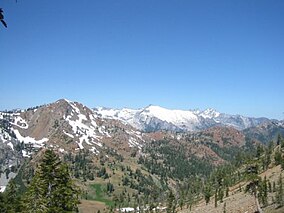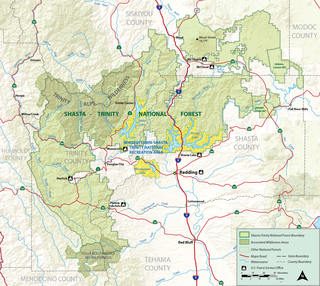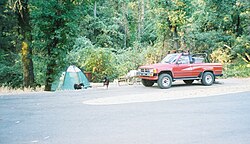| Shasta–Trinity National Forest | |
|---|---|
 Trinity Alps near Granite Lake | |
Map of the
United States | |
| Location | Northern California |
| Nearest city | Redding, California |
| Coordinates | 40°44′07″N 122°56′31″W / 40.73528°N 122.94194°W |
| Area | 2,209,832 acres (8,942.87 km2) |
| Established | 1954 |
| Governing body | U.S. Forest Service |
| Website | Shasta-Trinity National Forest |

The Shasta–Trinity National Forest is a federally designated forest in northern California, United States. It is the largest National Forest in California and is managed by the U.S. Forest Service. The 2,210,485 acre (894,552 Ha) forest encompasses five wilderness areas, hundreds of mountain lakes and 6,278 miles (10,103 km) of streams and rivers. Major features include Shasta Lake, the largest man-made lake in California and Mount Shasta, elevation 14,179 feet (4,322 m).
The Shasta–Trinity National Forest offers a wide range of recreational activities. Some of these include hiking, backpacking, mountain climbing, horseback riding, camping, boating, fishing, hunting, sightseeing, downhill skiing and riding, snowboarding, cross-country skiing, and snowmobiling.
In descending order of land area, the forests are located in parts of Trinity, Shasta, Siskiyou, Tehama, Modoc and Humboldt counties. [1]
History

In 1905, the first timber sale under the new US Forest Service agency occurred on what was then called the Shasta Reserve. [2] The Shasta National Forest (est.1905) and the Trinity National Forest (est.1905) were administratively combined in 1954. The new entity was officially renamed the Shasta–Trinity National Forest.
The Trinity National Forest is located in subranges of the Northern Inner California Coast Ranges and of the southeastern Klamath Mountains System, primarily in Trinity County, but also extending into parts of Tehama, Shasta, and Humboldt Counties. It has an area of 1,043,677 acres (422,361 ha).
The Shasta National Forest is located between the upper Sacramento Valley and the Shasta Valley to the north. It covers parts of Siskiyou, Shasta, Trinity, and Modoc Counties and has an area of 1,166,155 acres (471,926 ha).
The site was managed by the National Park Service from 1945 to 1948. [3]
Wilderness areas


The forests include portions of five congressionally designated Wilderness Areas:
- Castle Crags Wilderness
- Chanchelulla Wilderness
- Mount Shasta Wilderness
- Trinity Alps Wilderness (partly in Klamath NF, Six Rivers NF, or Bureau of Land Management land) [4]
- Yolla Bolly-Middle Eel Wilderness (partly in Mendocino NF, Six Rivers NF, or BLM land)
Vegetation
The Shasta–Trinity Forest lies at the intersection of the Eastern Klamath Mountains and the Southern Cascades (Miles & Goudy, 1997). The land is largely forested, though at low elevations there are areas of chaparral, woodland, and grassland. At high elevations in the Trinity Alps, Eddys, and Mt. Shasta, forest gives way once again to montane chaparral, subalpine woodlands, and ultimately to alpine rock and scree.
Starting with lower elevations in the foothills around Shasta Lake, north of Redding, the forests and woodlands are dominated by gray pine, knobcone pine, ponderosa pine, blue oak, black oak, canyon live oak and Douglas-fir. Shrub diversity is very high. Common understory shrubs at lower elevations are whiteleaf manzanita, wedgeleaf ceanothus, California buckeye, California coffeeberry and western redbud.
In moist stream canyons, other trees and shrubs prevail— bigleaf maple, western spicebush ( Calycanthus Occidentalis), dogwood, white alder, and willows.
At mid-elevations sugar pine, incense-cedar, white fir and Jeffrey pine join Douglas-fir, ponderosa pine, and canyon live oak, while the other pines and oaks drop out of the mix. Huckleberry oak, shrub tanoak, greenleaf and pinemat manzanitas, and bush chinquapin, are important understory components. In the Cascades east and north of Mt. Shasta, bitterbrush and tobacco brush are very common. On the serpentines of Trinity County's mid-elevation Klamath Mountains, incense-cedar and Jeffrey pine woodlands are inhabited by shrubby Congdon's silktassel, leather oak, and hoary manzanita. Farther west, on the long ridge of South Fork Mountain that divides the Shasta–Trinity and Six Rivers National Forests, the tree form of tanoak grows mixed with Douglas-fir and golden chinquapin.
Upper montane and subalpine forests are made up of red fir, mountain hemlock, western white pine, lodgepole pine; and at the highest elevations, foxtail and whitebark pines. Montane meadows and streamsides in the Klamath Ranges are marked by an abundance of California pitcherplant, western azalea, and occasional Port-Orford-cedar, which is disjunct here from its coastal populations.
Much more detail on the vegetation zones of Mount Shasta, and their associated flora and fauna, can be found in C. Hart Merriam's important early biological survey, published in 1899. [5]
| Common name | Scientific name |
|---|---|
| white fir | Abies concolor |
| red fir | Abies magnifica |
| bigleaf maple | Acer macrophyllum |
| California buckeye | Aesculus californica |
| white alder | Alnus rhombifolia |
| hoary manzanita | Arctostaphylos canescens |
| pinemat manzanita | Arctostaphylos nevadensis |
| greenleaf manzanita | Arctostaphylos patula |
| whiteleaf manzanita | Arctostaphylos viscida |
| incense-cedar | Calocedrus decurrens |
| western spicebush | Calycanthus occidentalis |
| wedgeleaf ceanothus | Ceanothus cuneatus |
| tobacco brush | Ceanothus velutinus |
| western redbud | Cercis occidentalis |
| Port-Orford-cedar | Chamaecyparis lawsoniana |
| golden chinquapin | Chrysolepis chrysophylla |
| bush chinquapin | Chrysolepis sempervirens |
| dogwood | Cornus (several species) |
| California pitcherplant | Darlingtonia californica |
| Congdon's silk-tassel | Garrya congdonii |
| tree tanoak | Lithocarpus densiflorus var. densiflorus |
| shrub tanoak | Lithocarpus densiflorus var. echinoides |
| Whitebark pine | Pinus albicaulis |
| knobcone pine | Pinus attenuata |
| foxtail pine | Pinus balfouriana |
| lodgepole pine | Pinus contorta |
| Jeffrey pine | Pinus jeffreyi |
| sugar pine | Pinus lambertiana |
| western white pine | Pinus monticola |
| ponderosa pine | Pinus ponderosa |
| gray pine | Pinus sabiniana |
| Douglas-fir | Pseudotsuga menziesii |
| Bitterbrush | Purshia tridentate |
| canyon live oak | Quercus chrysolepis |
| blue oak | Quercus douglasii |
| leather oak | Quercus durata |
| huckleberry oak | Quercus vaccinifolia |
| California coffeeberry | Rhamnus californica |
| western azalea | Rhododendron occidentale |
| willow | Salix (several species) |
| mountain hemlock | Tsuga mertensiana |
Lakes and rivers

The main branch of the Trinity River is a designated a National Wild and Scenic River which runs through the forest. The Shasta–Trinity National Forest also covers almost 70 percent of the watershed of the South Fork Trinity River, a tributary of the Trinity River.
Shasta, Lewiston and Trinity Lakes are part of the Whiskeytown–Shasta–Trinity National Recreation Area.
Shasta Lake has 365 miles (587 km) of shoreline made-up of many arms and inlets. The four major arms of the lake are: Sacramento, McCloud, Squaw Creek and Pit and have scenery as well as unusual geologic and historic areas.
Lewiston Lake, near the town of Weaverville, lies just downstream from Trinity Dam and Lake and just north of the town of Lewiston and is a constant level lake. It lies within the Whiskeytown–Shasta–Trinity National Recreation Area.
Iron Canyon (northeast of Shasta Lake, near the town of Big Bend), Lewiston, Lake McCloud (south of the town of McCloud), Shasta and Trinity Lakes are large reservoirs extensively used for fishing, boating and camping. Houseboats can also be rented at Shasta Lake.
There are many fishing opportunities in the forest. There are several alpine lakes in the Trinity Divide area (west and southwest of the town of Mt. Shasta City), most of which support trout. The Trinity River, near the town of Weaverville, is very popular for salmon and steelhead angling, as is the Stuart Fork of the Trinity River and such streams as Canyon Creek (closed to fishing below Canyon Creek Falls), Coffee, Grizzly, Rush and Swift Creeks, all of which drain the Trinity Alps Wilderness, also near Weaverville.
Peaks, trails and byways
The Shasta–Trinity National Forest has over 460 miles (740 km) [6] of trails including a 154-mile (248 km) section of the Pacific Crest Trail in an east–west direction.
The 500-mile (804.7 km) Volcanic Legacy Scenic Byway is an auto tour of northern California's volcanos and begins at Lassen Volcanic National Park, then to Mount Shasta and ends at Crater Lake National Park.
Beginning in McCloud, the Modoc Volcanic Scenic Byway travels through some unique volcanic scenery in the eastern portion of the Forest on its way to Medicine Lake, Lava Beds National Monument, and Tule Lake.
Lookouts and cabins

In the lavaflow area of Medicine Lake Volcano, is the Little Mt. Hoffman fire lookout. Restored to its original character, the lookout is now being offered as an overnight retreat for personal recreation use. From a height of 7,309 feet (2,228 m), Little Mt. Hoffman offers a view of Mt. Shasta, Lassen Peak, Mt. McLoughlin and a variety of other landforms. From the Tulelake Basin in the north to the Fall River valley in the south, the 360 degree view offers a view at some of northern California's most notable scenery. There is also Hirz lookout near Lake Shasta and the Post Creek lookout (somewhat near the town of Platina, on the southern end of the forest).
The Forest Glen cabin is a historic guard station, the oldest Forest Service building on the Shasta–Trinity National Forest. It was built in 1916 under the direction of John T. Grey, District Ranger of the Mad River Ranger District on the old Trinity National Forest. It is available for rent all year.
Footnotes
- ^ "Table 6 - NFS Acreage by State, Congressional District, and County, 30 September 2008". fs.fed.us. Archived from the original on 6 August 2017. Retrieved 4 May 2018.
- ^ Godfrey, Anthony, PhD The Ever-Changing View-A History of the National Forests in California USDA Forest Service Publishers, 2005 p. 92 ISBN 1-59351-428-X
- ^ You Can Still Visit These Six Former National Parks:Despite being delisted by the NPS, these spots are worth exploring thanks to their rich history and sheer beauty.
- ^ "Wilderness.net - Acreage Breakdown". Wilderness.net. Archived from the original on 3 March 2016. Retrieved 4 May 2018.
- ^ Merriam, C. Hart (Clinton Hart) (4 May 1899). "Results of a biological survey of mount Shasta, California". Washington, Govt Print. Off. Archived from the original on 27 August 2016. Retrieved 4 May 2018 – via Internet Archive.
- ^ "Official Forest Service website, list of recreation activities". usda.gov. Archived from the original on 8 July 2017. Retrieved 4 May 2018.
External links
- Shasta-Trinity National Forest
- National Forests of California
- Protected areas of Trinity County, California
- Protected areas of Shasta County, California
- Protected areas of Siskiyou County, California
- Protected areas of Tehama County, California
- Protected areas of Modoc County, California
- Protected areas of Humboldt County, California
- 1954 establishments in California
- Protected areas established in 1954
- Former national parks of the United States

